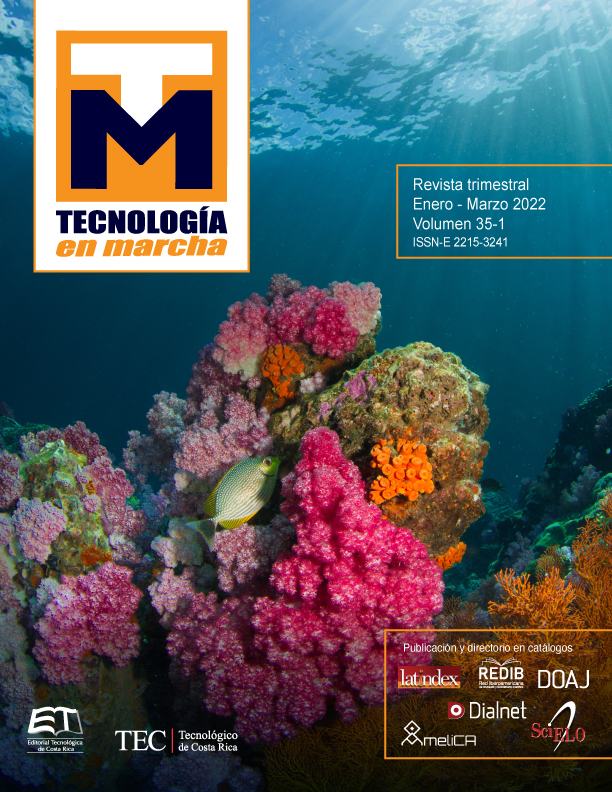Design and development of a microfluidic platform with interdigitated electrodes for electrical impedance spectroscopy
Main Article Content
Abstract
In this paper, we describe the design, manufacturing, and characterization of a sensor array suitable for implementing wide broad band EIS for samples in aqueous solution on a microfluidic platform. Its wide-ranging capacity will allow the development of fluid characterization studies with results that are not possible to obtain in systems with a lower frequency range. The microfluidic system consists of four filling chambers and the fluid transport channels required for flushing and filling. At the bottom section of each chamber there is a gold-deposited electrode that allows electrical interaction with the sample. The chamber’s geometry, transport channels, and the electrodes were designed using an optimization process through multiphysics simulations. Then, different manufacturing processes were developed experimentally for SU8 and PDMS which allowed to carry out the implementation of the microfluidic system. An electrical communication interface was designed for the interconnection of the microfluidic system with the vector network analyzer (VNA). Then, the measurements required to obtain the behavior of each sensor were developed.
The results obtained show a predominant capacitive behavior of each sensor from low frequencies up to 2 GHz, allowing to obtain sufficient contrast between different aqueous solutions and a good repeatability in different sensing chambers with the same solutions.
Article Details

This work is licensed under a Creative Commons Attribution-NonCommercial-NoDerivatives 4.0 International License.
Los autores conservan los derechos de autor y ceden a la revista el derecho de la primera publicación y pueda editarlo, reproducirlo, distribuirlo, exhibirlo y comunicarlo en el país y en el extranjero mediante medios impresos y electrónicos. Asimismo, asumen el compromiso sobre cualquier litigio o reclamación relacionada con derechos de propiedad intelectual, exonerando de responsabilidad a la Editorial Tecnológica de Costa Rica. Además, se establece que los autores pueden realizar otros acuerdos contractuales independientes y adicionales para la distribución no exclusiva de la versión del artículo publicado en esta revista (p. ej., incluirlo en un repositorio institucional o publicarlo en un libro) siempre que indiquen claramente que el trabajo se publicó por primera vez en esta revista.
References
R. Meissner, “Impedance spectroscopy for in vitro toxicology”, Ph.D. dissertation. Institut de Microtechnique, École Polytechnique Fédérale de Laussane, Switzerland, 2013.
T. M. Curtis, J. Tabb, L. Romeo, S. J. Schwager, M. W. Widder, W. H. van der Schalie. “Improved cell sensitivity and longevity in a rapid impedance-based toxicity sensor”, Journal of Applied Toxicology, 29(5):374-80, 2009.
H. S. Kim, Y. H. Cho, A. B. Frazier, G. Chen, D. Shin, A. Han, “Whole cell impedance analysis of metastatic and non-metastatic cancer cells”, in IEEE 22nd International Conference on Micro Electro Mechanical Systems, 2009, pp 399-402.
Qiao, Y et al. (2012) Bioimpedance Analysis for the characterization of Breast Cancer Cells in Suspension (Vol. 59, No. 8, pp. 2332-2329). IEEE Transactions on biomedical engineering.
Aberg, P. et al. Skin Cancer Identification Using Multifrequency Electrical Impedance—A Potential Screening Tool, IEEE Transactions on biomedical engineering, Vol. 51, No. 12, December 2004, pp. 2097-2102.
O’Rourke, A. et al. Dielectric properties of human normal, malignant and cirrhotic liver tissue: in vivo and ex vivo measurements from 0.5 to 20 GHz using a precision open-ended coaxial probe. Phys. Med. Biol. 52 (2007) 4707–4719
Jäger, M. et al. Impedance Measurements in Cell Cultures on Polymer Slides. IEEE 2006 Electronics System Integration Technology Conference, pp. 1203-1208.
Nacke, T. et al. Anwendungsmöglichkeiten der Impedanzspektroskopie in der Biotechnologie. Technisches Messen Plattform für Methoden, Systeme und Anwendungen der Messtechnik Vol. 69, Iss. 1/2002, pp. 12–18.
Hautmann, S. y Müller, J. In-situ biomass characterization by impedance spectroscopy using a full-bridge circuit. Bioprocess and Biosystems Engineering 24, 2001, pp. 137-141.
Asphahani, F. et al. Cellular Impedance Biosensors for Drug Screening and Toxin Detection. Analyst. 2007 September; 132(9): 835–841.
Grenier et al. Recent Advances in Microwave-Based Dielectric Spectroscopy at the Cellular Level for Cancer Investigations. IEEE Transactions on Microwave theory and techniques, Vol. 61, No. 5, May 2013, pp 2023-2030.
Grenier, K. et al. Microwave Dielectric Spectroscopy: an emerging analyzing technique for biological investigations at the cellular level. 2013 IEEE Topical Conference on Biomedical Wireless Technologies, Networks, and Sensing Systems (BioWireleSS) , 2013, pp 40-42.
S, Mobini, L. Leppik, and J.H. Barker, “Direct current electrical stimulation chamber for treating cells in vitro,” Biotechniques, vol. 60, no. 2. 2018.
R. García-Ramírez, et al., “Review on CMOS Circuit Architectures for Electrical Impedance Spectroscopy”, in Proc. IEEE Central America and Panama Convention (Concapan 2016), San José, Costa Rica, november 9-11, 2016.
R. García-Ramírez, et al. (2017), “A 0.13um CMOS Integrated Circuit for Electrical Impedance Spectroscopy from 1kHz to 10GHz” in Proc. IEEE 20th international System on Chip Conference, September 5-8, 2017, Hotel Novotel, Munich, Germany.
Stanford University, “Designing your own device: Basic design rules," 2017.
S. Sugiura, J.-i. Edahiro, K. Kikuchi, K. Sumaru, and T. Kanamori, Pressure-driven perfusion culture microchamber array for a parallel drug cytotoxicity assay," Biotechnology and bioengineering, vol. 100, no. 6, pp. 1156-1165, 2008.
T. Chen, D. Dubuc, M. Poupot, J.-J. Fournie, and K. Grenier, Accurate nanoliter liquid characterization up to 40 ghz for biomedical applications: Toward noninvasive living cell monitoring," IEEE Transactions on Microwave Theory and Techniques, vol. 60, no. 12, pp. 4171-4177, 2012.
Keysight Technologies, "@Keysight Technologies 2000-2020," 17 7 2020. [Online]. Available: https://www.keysight.com/zz/en/assets/7018-06806/application-notes/5980-2784.pdf?success=true. [Accessed 15 9 2020].

